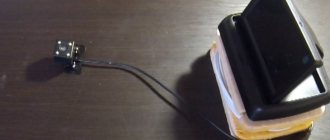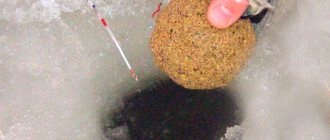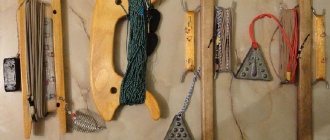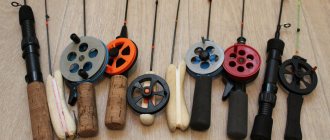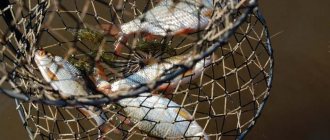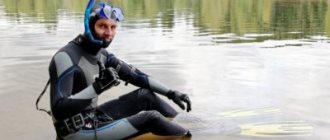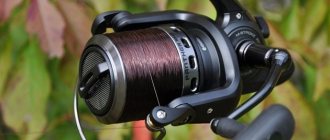How to choose a landing net
Before you buy a landing net, you need to decide on its shape and size, and for this you need to proceed from what kind of fish and in what conditions you will catch.
All landing nets differ in the size of the head (rim), the shape of the rim, the depth of the mesh, the size of the cell, the length of the handle, and the material of the handle. Now let’s look at these elements of the landing net in more detail.
It is worth noting that you can purchase landing nets either ready-made or take the landing net head and handle separately, which is very convenient. The head of a landing net is usually called a rim with a net.
Do-it-yourself weaving of fabric for a net
First of all, we prepare the shuttle. For manufacturing, you should take an aluminum sheet with a length of 20 cm. We construct a hole in the center of the sheet with a tongue, which will make it easier to work with the fishing line. Do not under any circumstances allow the thread to unwind during the manufacturing process! If desired, you can purchase a ready-made shuttle in a specialized store.
For weaving you will also need a non-slip ruler with parameters of 130-160 mm. It will make the process of tying knots easier. Having decided on the size of the network cells, we proceed to the workflow:
- We place the ruler in the left hand , and the broom and fishing line, which was wound in advance, in the right.
- We hook the loop using the index finger of our right hand. We adjust it to the ruler and take it out from under it on the opposite side.
- We make 2 turns around the finger on which the loop was originally located. We pass it under the ruler and pass it into a large loop. In a similar way we get 2 loops on the left hand.
- Supporting the thread of the loop with your finger, we drop the first one and tighten the butcher's broom.
- We adjust the exact location of the nodal part on the ruler. We press our finger and pull the needle over the ruler. At the same time, we lower the loop from the left hand.
- Tighten the knot firmly.
To obtain a cylindrical shape, we knit the net in a circle. The ideal mesh size is 25 mm, the depth of the burlap is about 60 cm. Having removed a sufficient size of the bag, we gradually narrow it and reduce the number of loops, gradually reducing them to zero. To give the landing net a good shape, tighten the last knot tightly.
Using store-bought fabric instead of homemade burlap, we shape it into a cylindrical shape and pull the bottom edges into a bun. At the bottom we equip the canvas with a weight, which will ensure that the bag quickly sinks into the water surface.
Hoop (base) for net
Having prepared the duralumin tube and iron wire in advance, we bend the hoop, giving it the shape of an oval (if desired, a circle). The diameter of the base directly depends on the weight of the catch. For small fish, a diameter of 32-35 cm is suitable, and for larger fish it is better to build a large hoop with a diameter of 50 cm. After giving the hoop the desired shape, we leave paired branches from it with a size of 12 cm. When calculating the distance, it should be taken into account that the handle of the net will be placed between the branches .
Making a handle for a net
We prepare a light wooden rod with a length of 1.20 m and a thickness of no more than 27 mm. We treat the surface with sandpaper. If desired, you can wrap it with insulating tape.
To connect the finished parts of the structure into one whole, you should:
- Fix the bag on the frame part.
- The edges of the frame are wrapped with nylon threads of increased strength. It is advisable to wind in several layers, which will prevent the fishing line from being damaged by sharp stones located at the bottom of the reservoir. In addition, the landing net will be transparent, which will not scare away the fish.
- We fasten the burlap with the handle of the net using soft wire. It is possible to ensure reliable fastening by using a clamp.
Auxiliary tackle is easy to use, but often saves the angler from missing a catch.
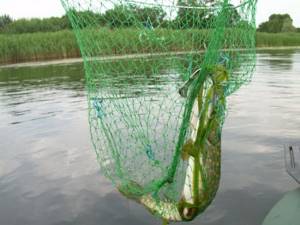
Landing net rim

The rim of the landing net can be from 30 to 100 cm in diameter.
The heaviest load in it falls on the attachment point with the handle, therefore, the attachment must be reliable, without unnecessary play.
Some landing nets have a rim that can be folded, making it more portable but less durable.
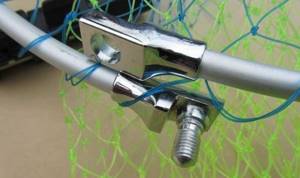
The rim shape is round, square and triangular. For small fish, round is preferable, and for medium and large fish, triangular and square are preferable.
Device
At first glance, all landing nets have a primitive design, but if you delve deeper into the topic, you will find that everything is not as simple as it seems. There are many varieties of these tools, each of which has its own design features. Of course, all models have common parts. A classic landing net consists of the following elements:
- Lever;
- Hoop;
- Net.
The tool is held by the handle, which, in turn, can have detachable connections and the ability to change the length or be solid. At its end there is a hoop, or, as it is also called, the head of the landing net - it serves as a frame for tensioning the net and helps the fisherman more accurately place fish into it.
The net, in turn, is positioned in such a way as to have a sufficiently deep pocket into which the fish falls and thanks to which it is pulled ashore. In order to have a more complete understanding of the design of various landing nets, it is necessary to consider some of the features of their elements separately.
Handle
It should be noted that there are quite a large number of different handles for landing nets. The main materials from which they are currently made include:
- Metal;
- Carbon fiber.
Metal handles can be made in two directions - more durable or lighter. If it is necessary to make a handle of light weight and at the same time sufficient strength, various aluminum alloys are used - this material cannot be called very reliable, but at the same time you can easily hold such a product with one hand. Another metal from which this element of the landing net is made is stainless steel.
Such handles, as a rule, are noticeably heavier and much less common, and also have a higher cost than aluminum analogues. The main advantage of stainless steel is its high strength, which is extremely important when catching trophy fish, when the tackle experiences resistance from prey of 10–15 kilograms.
Carbon fiber is used when it is necessary to use a landing net frequently - this is especially true at various fishing competitions. Its weight is extremely low, which is why fatigue from working with it is practically not felt, even if the tool is used with one hand.
For lightness combined with good reliability indicators, you usually have to overpay a little, however, if the landing net needs to be used for frequent fishing of small crucian carp in conditions of strong bite, the investment will be worth it. At the same time, the strength of such products is still inferior to metal ones, so the use of carbon fiber tools when catching trophy fish is usually not advisable.
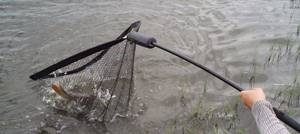
Despite its apparent fragility, a high-quality carbon fiber handle can withstand the resistance of a fish of five or even more kilograms.
In addition, there are three main options for manufacturing landing net handles:
- whole,
- telescopic,
- plug-in
Each of these designs has both its advantages and disadvantages. Handles made from a single piece of material usually have a significant advantage in strength over their folding counterparts, since they do not have additional weaknesses at the joints, however, in terms of transportation, they are much less convenient, since they take up a lot of space and simply do not fit everywhere. It is best to use such gear, but only if it is possible to comfortably deliver it to the fishing spot.
Folding telescopic landing nets are extremely easy to transport and use: they take up minimal free space in a car or boat, and can be easily placed even in a backpack. In addition, their working length can be changed depending on specific conditions, which is very convenient if the same landing net is used both for fishing from a boat and for shore fishing.
However, the apparent versatility comes at the price of reliability, since the connection is the main weak point of telescopic handles. This becomes especially relevant if the landing net needs to be used from time to time to catch large fish: the handle can not only turn at the point where one of its components enters another, but also simply break, especially when extended to its maximum length.
Important! Often the locking mechanisms cannot withstand the load, and the handle begins to spontaneously lengthen and shorten, and in the worst case, even break into two parts when tilted. Such situations are fraught for the fisherman with the loss of a long-awaited trophy.
The plug net is a kind of middle option, which is somewhat more reliable than a telescope, but at the same time has smaller transport dimensions than a solid one. The handles of such instruments consist of several elements - elbows, which are inserted into each other using special connectors. As in the case of spinning rods, such a connection is considered more durable than a telescopic one, but it cannot be called too reliable either.
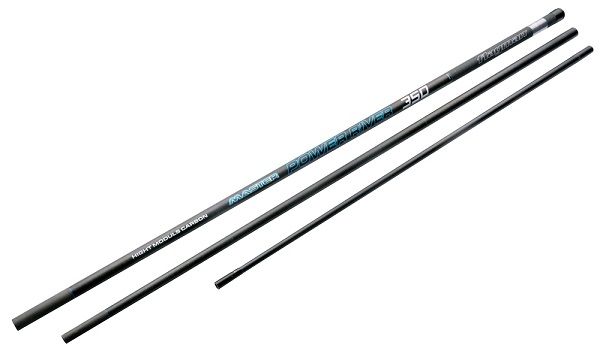
Good carbon handles for landing nets are usually made with a plug-type connection, since telescopic structures are considered not reliable enough in combination with this material.
When using such handles, it is necessary to regularly check the joints between the elements to avoid their separation at the most inopportune moment. The possibility of turning such a handle in the hands remains, however, since the force on the landing net is usually applied vertically, and not obliquely, this fact is not considered too important.
Breakage at the connection points is also not excluded, but the likelihood of this is lower than in the case of telescopic options. At the same time, such a handle can be easily assembled into a case, which is why, although it will take up more space than a telescopic one, it will still have a short transport length.
Hoop
The second most important part of any landing net is the head. It can have different sizes and shapes, and can also be made from various materials using several technologies. Most hoops found in modern stores have one of the following shapes:
- round or oval;
- rectangular;
- triangular;
- trapezoidal.
The choice of shape, as a rule, depends not only on the size and type of fish, but also on the habits of the fisherman: most people put the fish in the landing net from the front, but there are often those who find it more convenient to bring it under the trophy from the side. The former usually prefer triangular and trapezoidal hoops, but the latter, as a rule, prefer rectangular ones.
On a note! Sometimes the corners can serve as an additional point of support when fighting an unyielding trophy, but at the same time they can help him free himself from the hook by leaning on them, which also needs to be taken into account when choosing gear.

A wide variety of shapes, as a rule, allows you to choose the optimal hoop even for fairly picky anglers. Fishing yawn
Most often, landing net heads are made of metal. As in the case of handles, the most popular material for them are various kinds of aluminum alloys. Their lightness and fairly high strength make them suitable for catching most types of fish. The only exception can be considered truly trophy specimens, capable of bending aluminum tubes with their weight.
Since in most cases the hoop is hollow, stainless steel can also be used to make it. Due to the strength and rigidity of the material, tubes made from it are used with a smaller diameter, due to which an increase in weight, although it occurs, is not critical, while the reliability of the design increases multiple times. In addition, there are landing nets with a head made of composite materials, but they are also more often classified as sports options.
The greatest difficulty is choosing the design of the cage hoop. In this case, as in the case of the handle, it is necessary to make a choice in favor of either reliability or convenience. The classic type is solid hoops - they are the most durable and can help in landing even the largest fish. At the same time, they take up a lot of space during transportation, do not fit into bags and backpacks, and also get in the way in small boats.
Folding versions of hoops are considered the most convenient - they have special hinges that allow them to be folded in half, significantly reducing the space required for their transportation. They fit easily into bags and are convenient for traveling on a boat. However, at the same time, they most often break precisely at the joints, which is why such models are almost never used when catching trophy fish.
The third option is composite hoops - they consist of several parts inserted into each other. Such connections also weaken the structure, and if moved incorrectly, they may well separate, compromising the integrity of the head. The choice of the type and material of the hoop should also be based on the planned sizes and types of fish that will need to be fished with it.
Fishing landing net rim size
It should be understood that the larger the landing net, the more weight it must withstand. The rim of the landing net varies from 30 centimeters to 1 meter in diameter. The design features determine the weakest point, this is the place where the rim with the handle is attached; it is this place that needs to be given special attention when choosing. Backlashes and visible defects are not allowed, since in future use this particular place will remind of itself.
The shape of the rim can be different, it is believed that for small-sized fish a round shape is ideal, but for medium-sized and large-sized fish, a square or triangular head is preferable.
Net
There are several parameters that you need to pay attention to when choosing a grid. These include:
- material,
- mesh size,
- depth.
Modern landing nets are usually made from:
- fishing lines,
- fabrics,
- silicone.
Fishing line is the most popular material because it does not absorb water and odors, does not get dirty from mucus secreted by fish, and, most importantly, does not cling to hooks. Its main disadvantage can be considered not the highest strength compared to fabric options.
Fabric nets, which usually also include those made of nylon, have maximum tensile strength and, as a rule, are able to withstand even a very large trophy. However, at the same time they get wet, absorb odors and, which is especially unpleasant for those who like to catch predators, they cling to hooks. If fishing takes place with wobblers, especially large ones with three tees, then removing them from a fabric landing net turns fishing into hell. The sharp hooks pierce the mesh, and it is very difficult to pull them back out because of the jagged teeth. For this reason, fabric landing nets are usually used by fans of catching carp and carp, and for pike and pike perch they prefer models with a mesh made of fishing line.
The rarest type of landing net is silicone. They are neither very durable nor easy to use and are intended mainly for sport fishing for trout, lenok and other delicate fish species that are sensitive to physical impact.
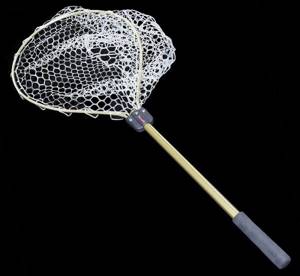
Silicone meshes are easy to clean and do not absorb odors, but they weigh more than fishing line options and are also much more expensive.
The mesh size must also be selected depending on the planned trophies. There is no need to collect garbage with a net with cells of a few millimeters when you plan to catch pike weighing more than 10 kilograms. Typically, a mesh with cells of 2–4 centimeters is ideal for catching most fish from 0.5 to 15 kilograms. If you use a larger one, jaws, gill covers and other protruding parts of fish will cling to it, while a smaller one works well as a slotted spoon for duckweed, algae, leaves and other surface debris.
As for the depth of the sag, this is one of the few cases when more is better than less. The reason for this is that it is much easier for active fish such as pike to jump out of a shallow landing net than from a deep one.
Handle for landing net (handle)
Handles range in length from 1 to 5 meters, and the longer it is, the more difficult it is to operate, but at the same time you can catch fish from a greater distance. A long handle will be convenient when fishing from the shore in thickets, a short handle will be convenient when fishing from a boat.
The longest landing nets are needed when fishing from a steep bank.
Most often, handles are made of aluminum, carbon fiber, and composite. The most inexpensive ones are aluminum, have good strength, but are heavy, that is, for active fishing they can be excessively heavy. Carbon fiber handles are lighter and more agile, but much more expensive and more fragile.
Landing net with carbon fiber handle
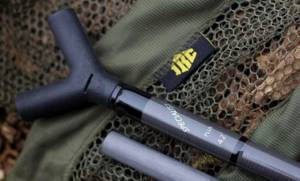
The handles are also non-folding and folding, the latter are easy to transport, but less durable. Folding models can consist of two or more separate parts using a plug-in method, or simply be telescopic, like a fishing rod.
Disadvantages and advantages of the landing net I bought
And now about the disadvantages and advantages of the landing net purchased before fishing, which is shown in the photo. I will comment on the shortcomings and compare with other more powerful devices. The most vulnerable parts of these Chinese counterfeits are the connection points of the telescopic handle and the frame assembly unit. First of all, they are the ones who “fly”, especially under extreme pressure, which happens when catching a large fish or when playing the fish incorrectly, when they start catching it with a landing net, instead of bringing the caught prey to a landing net slightly submerged under water. Or when, instead of pulling the fish through the water, they begin to lift it through the air. Some weak landing nets cannot withstand such loads on the first day of fishing. But in general, these units can work for quite a long time without breakdowns. True, the plastic liners of the connections wear out. But nothing lasts forever... The telescopic handle made of aluminum alloys is inferior in lightness to carbon fiber handles, but they are too flexible when fishing for large prey and are flimsy. In addition, carbon fiber is brittle and cannot withstand impact loads. But if you compare a telescopic handle with a plug handle, the latter will be more reliable.
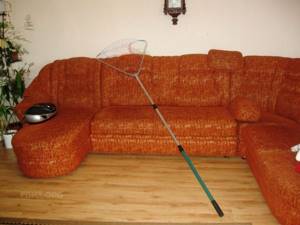
Pike landing net
To catch large predators, and even more so pike, stronger and deeper landing nets made of thick fishing line with a large mesh are used. A triangular rim shape would be more preferable.
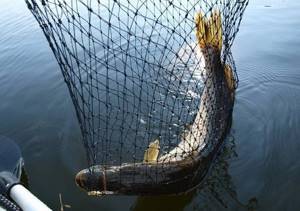
In spinning fishing, landing nets with a nylon mesh should not be used, since the tees of wobblers, spinners and other baits will constantly cling to the fibers of the nylon, which is very inconvenient.
To receive large pike, from 5 kg or more, a mesh with a cell of 3-5 cm is considered optimal.
For the boat and for the shore
The choice of landing net largely depends on the conditions in which it will be used. For example, the difference between boat and shore landing nets is quite large. Moreover, the types of fish that will be caught with its help are also of no small importance. For example, a coastal carp landing net is, as a rule, much longer and more massive than equipment for catching pike. This is justified by the fact that feeder fishing for carp is often carried out in overgrown areas of reservoirs, and for the same reason it is not possible to bring a powerfully resisting carp or carp to the shore, since, relying on water lilies and algae, it will easily tear off the hook. Because of this, it has to be placed in a landing net three or even four meters from the shore. At the same time, even a large pike can usually be brought to a distance of 1.5–2 meters from the water’s edge, tying it up due to the elasticity of the rod.
Important! Due to the considerable length of the predator, the size of the hoop when catching it should be slightly larger than when fishing for peaceful fish, since a ten-kilogram pike can reach a length one and a half times greater than a carp of the same weight, which is why it will be very difficult to drive it into a small landing net. difficult.
Boat landing nets are usually much shorter and are much easier to select since their short distances and corresponding short lever length mean they have lower strength requirements. Most fishermen who catch trophy specimens from a boat recommend using a tool about 1.5–2 meters long with a minimum number of joints.
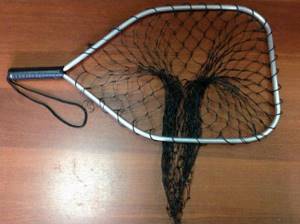
Many fishermen prefer to bring the fish as close to the boat as possible and only then bring it into the landing net. In this case, special boat models with a shortened handle are used.
And you also need to pay attention to the connection between the handle and the hoop - it must be very reliable. It is better not to use gear with regular threads on a thin aluminum tube - this is where breakage often occurs. It would be better to have a reinforced plug connection.
Unusual, but practical and quite reliable, this unit is implemented on Kaida carp landing nets - the plug connection is equipped with a special latch. They feature a combined hoop design - its side faces are made of metal tubes, while the front is a dense cord that does not allow strong carp and carps to use the landing net head frame as a support point. Despite the modular design, Kaida is considered to be quite durable tools, on par with gear from famous brands such as Rapala.
To catch not too large trophies from a boat, it is quite possible to choose lightweight, budget models of landing nets. In this case, you can pay attention to the products of the Polish company Salmo or the domestic Volzhanka. Boat fishing requires the presence of a strong hoop, preferably solid, and a relatively light, folding handle, since the load on the latter during such fishing is usually less than during coastal fishing.
On a note! It will be good if the hollow tubes of the landing net will keep it afloat for at least a few tens of seconds, since often the tackle during a fish jerk or simply by accident ends up overboard, and floating models in this case will have a huge advantage. In shore nets, this does not matter, since even when they fall into the water, they rarely end up at a depth of more than a few tens of centimeters, from where they can be easily retrieved.
Silicone landing net
This tool is the safest for catching fish, since the silicone mesh has a large area, which is why the load on the fish is distributed more evenly.
